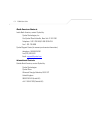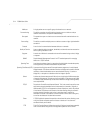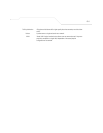
ES3000 User Guide
GL-2
Backbone The part of a network used as a primary path for transporting traffic between network
segments.
Bandwidth The information capacity, measured in bits per second, that a channel could transmit.
Bandwidth examples include 10 Mbps for Ethernet, 100 Mbps for Fast Ethernet, and
1000 Mbps (I Gbps) for Gigabit Ethernet.
Baud The signaling rate of a line, that is, the number of transitions (voltage or frequency
changes) made per second. Also known as line speed.
Broadcast A packet sent to all devices on a network.
Broadcast storm Multiple simultaneous broadcasts that typically absorb all the available network
bandwidth and can cause a network to fail. Broadcast storms can be due to faulty
network devices or network loops.
Capacity planning Determining whether current solutions can satisfy future demands. Capacity planning
includes evaluating potential workload and infrastructure changes.
Class of Service A term to describe treating different types of traffic with different levels of service
priority. Higher priority traffic gets faster treatment during times of switch congestion
Collision A term used to describe two colliding packets in an Ethernet network. Collisions are
a part of normal Ethernet operation, but a sudden prolonged increase in the number
of collisions can indicate a problem with a device, particularly if it is not accompanied
by a general increase in traffic.
Endstation A computer, printer, or server that is connected to a network.
Ethernet A LAN specification developed jointly by Xerox, Intel and Digital Equipment
Corporation. Ethernet networks transmit packets at a rate of 10 Mbps.
Fast Ethernet An Ethernet system that is designed to operate at 100 Mbps.
Gigabit Ethernet An Ethernet system that is designed to operate at 1000 Mbps (1 Gbps).
Fault isolation A technique for identifying and alerting administrators about connections (such as
those associated with switch ports) that are experiencing congestion or failure, or
exceeding an administrator-defined threshold.
Forwarding The process of sending a packet toward its destination using a networking device.
Filtering The process of screening a packet for certain characteristics, such as source address,
destination address, or protocol. Filtering is used to determine whether traffic is to
be forwarded, and can also prevent unauthorized access to a network or network
devices.
Flow control A congestion- control mechanism. Congestion is caused by devices sending traffic to
already overloaded port on a switch. Flow control prevents packet loss and
temporarily inhibits devices from generating more traffic until the period of
congestion ends.


















